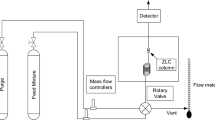Summary
Equations are derived which use the retention indices (I) to estimate the partition coefficients (K) and the partial molar enthalpies (ΔHs), entropies (ΔSs), and free energies (ΔGs), of solution.
The values of I and V og obtained on Apiezon-M or Polyethylenglycol-1000 have been used to calculate ΔHs of benzene and a number of organic sulfur compounds at 60 to 100°C. The discrepancy between the two methods is not in excess of ±0.3 kcal/mole.
ΔHs of some compounds in SE-30, PEG-20,000, XF-1150, Triton X-305 and the values of K in Squalane at 80 °C have been calculated with the use of the proposed equations and I fromMcReynolds' tables. As a rule, the agreement with the usual calculation through V og is better than 1%.
Another equation is derived to estimate the selectivity of the stationary phases from the retention indices. The equation gives the separation factor (αi, j), the relative activity coefficient (γ ∞i, j ) and the differences in the partial molar free energies (ΔΔGE), enthalpies (ΔΔHE), or entropies (ΔΔSE), of mixing.
The equation has been used to estimate the selectivity of Apiezon-M and PEG-1000 towards three types of organic sulfur compounds, di-n-propyl sulfide, n-hexyl mercaptan, and diethyl disufide.
Zusammenfassung
Es werden Gleichungen abgeleitet, mit deren Hilfe sich aus den Retentions-Indices (I) die Verteilungskoeffizienten (K) und die partiellen molaren Enthalpien (ΔHs), Entropien (ΔSs) und freien Energien (ΔGs) einer Lösung abschätzen lassen. Die auf Apiezon-M oder Polyäthylenglykol-1000 erhaltenen Werte für I und V og wurden zur Berechnung von ΔHs für Benzol und eine Anzahl organischer Schwefelverbindungen bei 60 bis 100 °C verwendet. Die Diskrepanz zwischen beiden Methoden übersteigt nicht ±0,3 kcal/Mol. Für einige Verbindungen wurden die ΔHs-Werte auf SE-30, PEG-20.000, XF-1150, Triton X-305 und die K-Werte auf Squalan bei 80 °C unter Verwendung der vorgeschlagenen Gleichungen und des I aus denReynolds'schen Tafeln berechnet. Generell ist die übereinstimmung mit der üblichen Berechnung über V og besser als 1 %. Eine weitere Gleichung wurde abgeleitet, um die Selektivität der stationären Phasen aus den Retentionsindices abzuschätzen. Die Gleichung gibt den Trennfaktor (αi, j), den relativen Aktivitätskoeffizienten (γ ∞i, j ) und die Unterschiede in den partiellen molaren freien Energien (ΔΔGE), Enthalpien (ΔΔHE) bzw. Entropien (ΔΔSE) der Mischung an. Die Gleichung wurde zur Abschätzung der Selektivität von Apiezon M und PEG 1000 gegenüber drei verschiedenen organischen Schwefelverbindungen verwendet, nämlich Di-n-propylsulfid, n-Hexylmercaptan und Diäthyldisulfid.
Résumé
On établit des équations qui utilisent les indices de rétention (I) pour estimer les coefficients de partage (K), ainsi que les enthalpies molaires partielles (ΔHs), les entropies (ΔSs) et les énergies libres (ΔGs) d'une solution. Les valeurs I et V og obtenues sur Apiezon-M ou sur Polyéthylène-glycol 1000 ont été employées pour calculer les ΔHs de benzène et de plusieurs composés organiques du soufre entre 60 et 100 °C. La divergence entre les résultats obtenus par les deux méthodes n'excède pas ±0,3 kcal/mole. Les valeurs de ΔHs de quelques composés ont été obtenues sur SE-30, PEG-20.000, XF-1150, Triton X-305, et les valeurs K sur Squalane à 80 °C, à l'aide des équations proposées et des valeurs I prises des tableaux deReynolds. En général, la concordance entre ces valeurs et celles calculées des V og , méthode employé normalement, est meilleure que 1 %. Une autre équation est établie pour estimer la sélectivité des phases fixes à partir des indices de rétention. L'équation comprend le facteur de séparation (αi, j), le coefficient relatif d'activité (γ ∞i, j ), ainsi que les différences dans les énergies libres partieles molaires (ΔΔGE), les enthalpies (ΔΔHE), ou les entropies (ΔΔSE) de mélange. L'équation a été employée pour estimer la sélectivité de l'Apiezon-M et du PEG 1000 pour trois types de composés organiques du soufre: di-n-propyl sulfure, n-hexyl mercaptan, et di-éthyl disulfure.
Similar content being viewed by others
Literature
E. Kováts: Helv. Chim. Acta.41, 1921 (1958).
A. Wehrli, E. Kováts: Helv. Chim. Acta,42, 2709 (1959).
M. B. Evans: J. Gas. Chromat.,4, 1 (1966).
W. O. McReynolds: Gas chromatographic Retention Data, Preston Technical Abs., Evanston, I, 1966.
R. Hatch: J. Gas Chromat.6, 611 (1969).
D. Zarazir, P. Chovin, G. Guiochon: Chromatographia,3, 184 (1970).
S. S. Yufit, B. A. Rudenko, J. A. Krasnaja, V. F. Kucherov: Dokl. Akad. Nauk SSSR,188, 156 (1969).
D. A. Tourres: J. Chromat.,30, 357 (1967).
L. S. Ettre, K. Bubleb, J. Chromat.30, 12 (1967).
R. Kaiser: Chromatographia,3, 127 (1970).
R. Kaiser: Chromatographia,3, 383 (1970).
J. Takács, D. Králik: J. Chromat.,50, 379 (1970).
J. E. Oberholtzer, L. B. Rogers: Anal. Chem.,40, 1234 (1969).
R. V. Golovnya, Yu. N. Arsenyev: Chromatographia,3, 455 (1970).
B. L. Karger: Anal. Chem.,39, 24 A (1967).
D. H. Desty, W. T. Swanton: J. Phys. Chem.,65, N5, 766 (1961).
E. Kováts: Advances in Chromatography, v. 1, J. C. Giddings, and R. A. Keller, eds., Marcel-Dekker, New York, 1965, p. 229.
R. V. Golovnya, Yu. N. Arsenyev: Dokl. Akad. Nauk SSSR,192, 112 (1970).
M. R. James, J. C. Giddings, H. Eyring: J. Phys. Chem.,68, N7, 1725 (1964).
H. Strickler, E. Kováts: J. Chromat.,8, 289 (1962).
S. H. Langer, R. J. Sheehan: Progress in Gas Chromatography, ed.J. H. Purnell, New York/London/Sydney, 1968, p. 289.
L. Rohrshneider: Z. Anal. Chem.211, 18 (1965).
L. Rohrschneider: J. Chromat.,22, 6 (1966).
W. R. Supina, L. P. Rose: J. Chromat. Sci.,8, 214 (1970).
R. V. Golovnya, Yu. N. Arsenyev: Izv. Akad. Nauk SSSR, ser. khim.6, 1399 (1970).
M. L. Peterson, J. Hirsch: J. Lipid Res.1, 132 (1959).
M. R. James, J. C. Giddings, R. A. Keller, J. Gas. Chromat.,3, 57 (1965).
J. R. Conder: Progress in Gas Chromatography, ed. J. H. Purnell, New York/London/Sydney, 1968, p. 247.
G. Blu, L. Jacob, G. Guiochon: J. Chromat.,50, 1 (1970).
J. Bonastre, Ph. Grenier: Bull. Soc. chim. France, 1292 (1968).
Author information
Authors and Affiliations
Rights and permissions
About this article
Cite this article
Golovnya, R.V., Arsenyev, Y.N. Estimation of thermodynamic quantities from retention indices. Chromatographia 4, 250–258 (1971). https://doi.org/10.1007/BF02285015
Received:
Accepted:
Issue Date:
DOI: https://doi.org/10.1007/BF02285015




